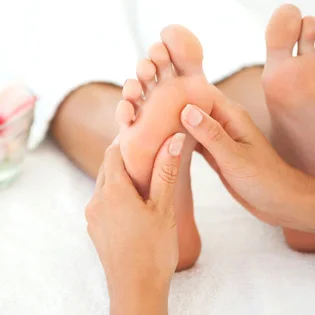Ankle, Foot & Heel Injuries
The most common operative ailments treated for the ankle joint and subtalar joint (the joint below the ankle) are lateral compression syndrome, ankle instability, and osteoarthritis and tendonitis. Our staff includes Board-Certified Orthopedic and Podiatric Doctors in Broward County, Florida who treat the full spectrum of ankle, foot, and heel conditions. Call 754-205-0682 or fill out the form on the right to receive the highest standard of orthopedic care in the Broward County.
Achilles Tendonitis
The Achilles tendon is the largest tendon in the body. It connects the calf muscle to the heel bone and is used when walking, running, and jumping.
Achilles tendonitis is a common condition that causes pain along the back of the leg near the heel. It is caused by injury or disease resulting in swelling, pain, and/or irritation. The two types of tendonitis are noninsertional and insertional. With noninsertional Achilles tendonitis, fibers in the middle portion of the tendon have begun to break down with tiny tears, swell, and thicken. Insertional tendonitis involves the lower portion of the heel where the tendon attaches to the heel bone. With both types, damaged tendons may harden, and bone spurs may form.
The condition occurs in athletes and non-athletes alike and is caused by repetitive stress to the tendon. Symptoms include:
Pain and stiffness
Severe pain the day after exercising
Thickening of the tendon
Bone spur
Swelling
A sudden “pop” may indicate a ruptured Achilles tendon. Please call immediately if you think you may have ruptured or torn your tendon.
Our staff diagnoses Achilles tendonitis with a physical exam and imaging (x-rays, MRI), and may offer non-surgical and surgical treatments to help heal the condition or injury.
Ankle Instability
Ankle instability is when the outer side of the ankle “gives way” time and time again. People with chronic ankle instability experience a repeated turning of the ankle; persistent discomfort and swelling; pain or tenderness; and/or the ankle feeling wobbly.
Ankle instability might develop from an ankle sprain that did not heal properly or that was not rehabilitated completely. When a person sprains an ankle, the connective tissues, or ligaments, are stretched or torn. Physical therapy is needed to strengthen the muscles around the ankle and “retrain” the tissues within the ankle that affect balance.
Repeated ankle sprains often cause chronic ankle instability. Each subsequent sprain leads to further weakening or stretching of the ligaments, resulting in greater instability and the likelihood of developing additional problems in the ankle.
In addition to physical therapy, our doctor might also recommend bracing, medication, or surgery for ankle stability treatment.
Heel Spurs
As people age, bones grow and edges may sharpen. These little growths on the outside of the bone are sharpened edges called bone spurs, and they may cause pain by rubbing on nerves or pinching tendons.
After diagnosing heel bone spurs with a physical exam and imaging (x-rays, MRI), our doctor might recommend non-surgical treatments and arthroscopic surgery to relieve pain and to help the patient become pain free in the heel.
Plantar Fasciitis
Plantar fasciitis causes pain on the bottom of the heel. It occurs when the strong band of tissue that supports the arch of the foot becomes irritated and inflamed. This area is called the plantar fascia and is a long, thin ligament that connects the heel to the front of the foot. Sometimes, the plantar fascia becomes damaged from too much pressure.
People suffering from plantar fasciitis feel heel pain and stiffness.
Our staff diagnoses plantar fasciitis by a physical exam and imaging (x-rays, MRI) when necessary. We offer a variety of non-surgical treatments, including cortisone injections, medication, and physical therapy.
Osteoarthritis
Osteoarthritis (OA) sometimes called degenerative joint disease, is the most common form of arthritis. Arthritic joints occur when there is a loss or damage to cartilage. This loss of shock absorption causes inflammation and pain. For effective relief form osteoarthritis related pain and movement limitations, call 754-205-0682.
While osteoarthritis can affect any joint in your body, the disorder most commonly affects joints in your knees, hands, hips, feet, and spine. Osteoarthritis commonly occurs after the age of 40 and gradually worsens over time.
While no cure exists, treatments are available that can relieve pain and help you remain active. Taking steps to actively manage your osteoarthritis may help you gain control over your symptoms.
Common symptoms of osteoarthritis include:
Pain, tenderness, or stiffness in your joint
Loss of flexibility in your joint
Bone spurs, which are extra bits of bone that feel like hard lumps and may form around the affected joint
Tendonitis
Overuse or damage to the tendon over a long period of time can cause the collagen fibers in the tendons to form small tears, a condition called tendonitis. When tendonitis occurs, movement in the area of the inflamed or torn tendon will become very painful.
Tendonitis is almost always diagnosed upon physical examination. Common symptoms include:
Tenderness directly over the tendon
Pain with movement of muscles and tendons
Swelling of the tendon
Occasionally, there is an anatomical cause for tendonitis. If the tendon does not have a smooth path to glide along, it will be more likely to become irritated and inflamed. In these unusual situations, surgical treatment may be necessary to realign the tendon.













